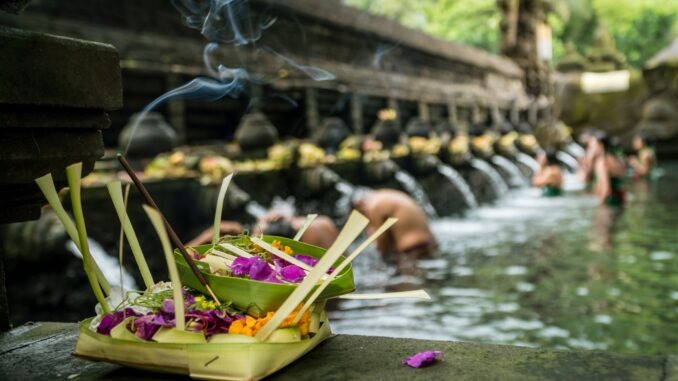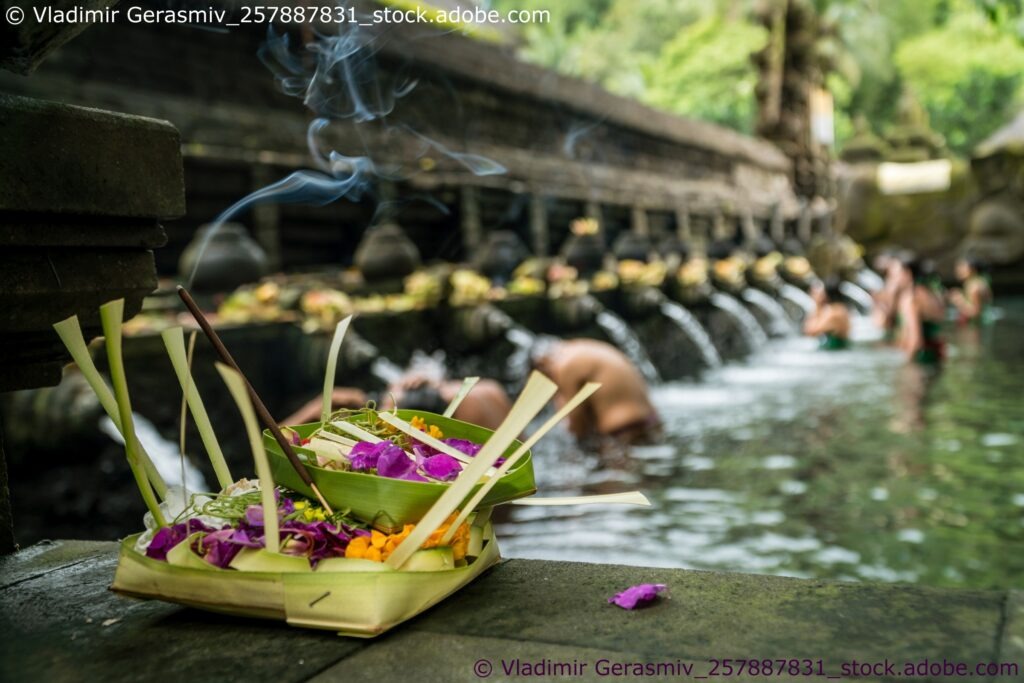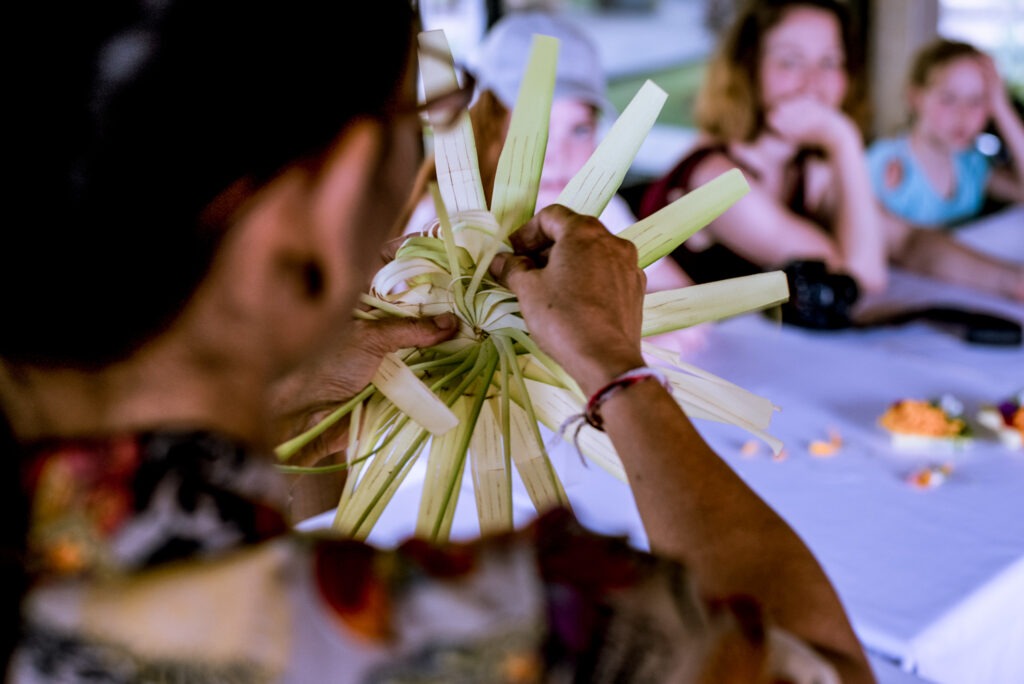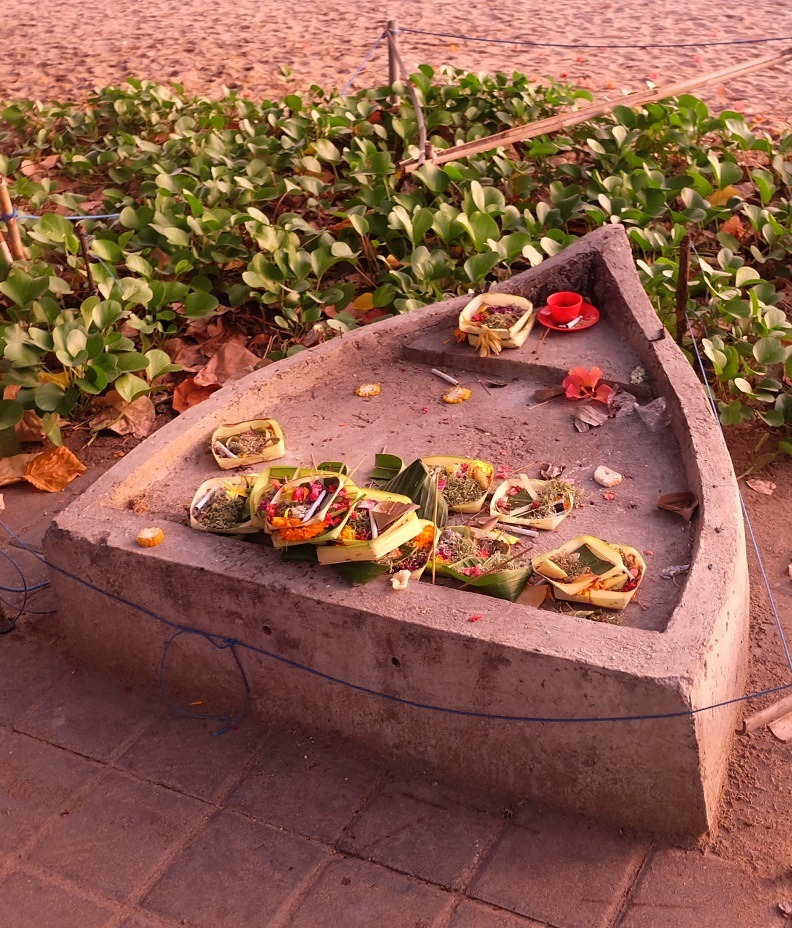
Table of Content:
Have you ever walked down a street in Bali and seen an attractive little square woven basket made of banana leaves and filled with flowers?
Or, while visiting a temple, did you see how Balinese people carried unique towers of different fruits during traditional ceremonies? These are called Balinese offerings.

Balinese offerings can be found in every corner of Bali. From a few grains of rice stuck on a piece of banana leaf, to the daily small offerings placed around the house, to the towers of fruit, cakes, poultry and livestock carried in procession to the temple, Balinese offerings are something you will see everyday in Bali.
One of the Balinese offerings that you will see frequently, especially on the street, is the daily offering called canang sari. It is unique and beautiful, but more importantly, it has a deep meaning and purpose in the heart of the Balinese people. Are you curious enough about canang sari and other Balinese offerings? Follow our explanations here to gain a better understanding.
What is Canang Sari?
Canang Sari is a Balinese offering made daily to express gratitude and honor to the Sang Hyang Widhi Wasa (God) or the creators of life. The offerings symbolize praise and prayer to maintain balance and peace on earth, between good and evil, between gods and demons, between heaven and hell.
As a daily offering, canang sari are placed everywhere, at the foot of temples, on statues, at the front door of a house or store, on motorcycles, on the beach, everywhere. The word ‘canang’ refers to the tray and ‘sari’ to the contents of the offering, such as cash, snacks and cigarettes. It usually contains different flowers that have different meanings and are placed in certain directions.
The making of the Canang Sari is done by the Balinese women and has become their daily life. It is said that a good wife should know how to make canang sari. But in recent years, you can also buy Canang Sari in traditional markets in Bali. However, the meaning and purpose of the sari remained the same.

As it is a sacred and traditional thing, women must wear a sarong and sash when praying and draping the canang sari out of respect to the gods. The ritual must be repeated every morning.
Parts and the meaning of the Canang Sari

The Canang Sari consists of some parts, such as Peporosan, Ceper, Raka-Raka and Sampian Urasari. Peporosan is the core material made from betel leaves, lime, gambier, prestige, tobacco and betel nuts. The material of peporosan symbolizes the Trimurti, the three great Hindu gods. Shiva is symbolized by lime, Vishnu by betel nut and Brahma by gambier.
The canang sari is covered by a tray of palm leaves called a ceper, which serves as a symbol of Ardha Candra. Raka-raka is topped by sampian urasari, which in turn are overlaid by flowers placed in a particular direction. Canang Sari uses flowers of different colors placed in certain directions, each symbolizing a Hindu god.
- White flowers: point to the east and are a symbol of Iswara, one of the primary forms of the god
- Red flowers: point south and are a symbol of Brahma, one of the highest in the triad of great Hindu gods
- Yellow flowers: pointing west as a symbol of Mahadeva, the Supreme God
- Blue or green flowers facing north are a symbol of Vishnu, the preserver within the Hindu trinity of deity
A canang sari is completed by placing on the canang an amount of kepeng (coin/paper money) said to constitute the sari (essence) of the offerings themselves.
Purpose of the Canang Sari
The Balinese believe that the cosmos is divided into three levels: heaven, where the Hindu gods live, the world, where humans live, and hell, where the demons dwell. Canang Sari aims to maintain the balance between good and evil, as it is used to show gratitude to the gods in heaven. But it also honors the demons in hell so that they stay where they are and do not enter the world.
During the ritual of canang sari placement, the crucial element is a prayer that is said to take the canang sari (essence) to heaven. For each canang sari, a jepun flower is dipped in water from a sacred spring.
In addition, the sacred water is used to sprinkle the canang in a symbolic fusion of earth, fire, wind and water. After the palms of the canang basket are tied together, a prayer is said while the smoke of burning incense carries the essence of the offering to the gods.
Other types of Balinese offerings
Besides the Canang Sari, the daily offering, there are other types of Balinese offerings. All offerings consist of basic components such as fire, water, and flowers, while the additional items correspond to the profession, wealth, and season in which they are offered. Since this is a sacred ritual, all offerings must use high quality ingredients and be purified prior to offering.
Here are some types of other Balinese offerings you will see in Bali:
Daksina
Daksina is one of the most important offerings in Bali, used for great ceremonies such as weddings or birth ceremonies. Daksina is made from coconut or lontar leaves and has bucket shapes consisting of coconut, egg, uncooked rice, fruit and more. This offering is used to show gratitude and to ask God for salvation.
Banten Peras
Banten Peras are offerings consisting of uncooked rice, fruits, coins and other items placed in a bamboo plate. This offering is used to open a ceremony and is accompanied by a Daksina offering. Bantun Peras is a mandatory offering for a ceremony, as it is used to ask for the success of the ceremony.
Banten Pejati
Banten Pejati is used to express sincerity towards Sang Hyang Widhi and its manifestation. This offering can be used at any ceremony, no matter when or where. Banten Pejati is also called ‘Banten Peras Daksina’ because it has the same effect as the Daksina offering.
Banten Ajuman
Banten Ajuman consists of fruits like oranges or bananas, snacks or bread, sometimes yellow rice is used. This offering is also made of coconut leaves, like the other Balinese offerings, but has a round shape.
Gebogan
Gebogan are tower-shaped offerings consisting of fruits and cakes. They are beautiful and colorful, because Gebogan is used to thank God for the infinite blessings. When this offering is used for a ceremony, Balinese women carry it on their heads on the way to the temples.
Life lessons from Balinese offerings
After learning the meaning and purpose of Balinese offerings, you must be careful not to step on them on the street in Bali. Also, you can draw some lessons for your life from the sacred Balinese tradition of sacrifice.
Taking time and making sense
Bring more joy into our lives and be grateful for every moment, whether it is simple or complex. Start living your life with a common concept that can make a big difference in your life and for others as well.
Being instead of doing
Leave the to-do lists behind and start building a relationship with yourself or others. It is important to know your authentic self and your true side.
External focus
Focusing on somethingoutside of yourself can help you avoid becoming overwhelmed, anxious, or feeling isolated. Start by using the recognition of our feelings as a signal that we may need a change on the outside to change your inner experience.
Show gratitude
By thinking about what you are grateful for and expressing that daily, you can increase your sense of happiness and bring quality time into your daily life.
Rituals, devotion and faith
As you begin to commit to things that are important in your life, you will develop a deep sense of purpose and connection with yourself and even with others. In the long run, this commitment will help you develop confidence and faith in yourself.
Life is sacred
Living your life as something sacred means that you will cherish every beautiful moment, every experience, and every good connection that occurs. Take a moment now to reflect on the magic of being human and the lessons you have learned in life.
So there you have it, everything you need to know about daily Balinese offerings. What it is, the meaning behind it and what other types of Balinese offerings there are, we have explained here. You can also learn what lessons Balinese offerings can give in life.
